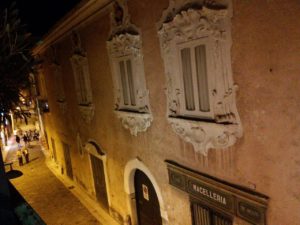The city of Caiazzo is located at 200 meters above sea level perched on a hill, slightly sloping towards the south, a pass between the middle and lower Volturno valley at the foot of Monte Grande, one of the peaks of the Trebulani Mountains chain.
The territory of Caiazzo consists of an ancient village surrounded by splendid hills that face, depending on the orientation, towards the Trebulani Mountains, the Matese Mountains, Monte Taburno. The rural area is an ideal place for our bicycle and E-Bike excursions.

he origins and history
Legends tell that Caiazzo was founded by Calatia, a nymph daughter of Tifata, ardently loved by the god Volturno, who took refuge in this place to escape the anger of her father. The ancient writers spoke of it as a “perantiqua”, that is, an ancient city, while ancient historians claim that Caiatia was founded by the Osci between the ninth and eighth centuries BC. On the castle hill there are remains of polygonal walls that testify to this thesis. The city was largely refounded in Roman times on a plane slightly inclined towards the south, had in the center a decumanus, overlooked by fourteen hinges or crossbars, almost all in. In the center stood the forum, in which the praiseworthy caiatine Marco Gavio built support parapets. Contained in the large urban square, a smaller square stands out, probably the remains of a Caiazzo built with Greek techniques, after the population descended from the restricted acropolis to its present location.
During the second Samnite war it was conquered by the consul Giunio Bubulco; around 90 y. C. was violently sacked by Silla, since she had sided with the Italics in the social war. He had had a mint in the Oscan era, and he got it back in the imperial era. It had the Roman colony, became a municipality, and was enrolled in the rustic Falerna tribe. Various roads joined it to Casilino, Capua, Trebula, Telesia and Compulteria. Some people speak of Italic cults from Campania in Caiazzo: Giano, Evone (Apollo from Campania), Priapus.
In imperial times it is known about the temple of Venus (perhaps near S. Maria di Costantinopoli) and others. An effigy preserved in the seat of the current Pro Loco that says “happy Venus” is testimony to this. Some plaques are honorary, and repeat names of the imperial house Giulia. This made one think either of benefits obtained or of the presence in Caiazzo and its surroundings (Cesarano) of people or facts pertaining to the imperial house. With the Lombards Caiazzo was gastaldato then, when Capua was elevated to principality, Caiazzo passed county; first count seems to have been Arialdo. It was consignory, and therefore all males succeeded the parent. It lasted until 1058, and the last Lombard accounts were Landenulfo and Giovanni. The Normans de Quarrel (de Quadrells) Drengot princes of Capua, were also counts of Caiazzo, around 1065-70. Rainulfo II participated in the crusade, and with him some knights of Caiazzo went to the Holy Land: three Melchiorri, and a Priscus, Plancano, Gizi, Gentile, Sparano. The county remained at the Corona for a time, and with Casa Angiò it was given to the De Clignette, then, by marriage, to the Sanseverino: first of them Roberto died in Trento. In 1501 Gianfrancesco was succeeded, and to these in 1507 Roberto. Dai Sanseverino passed to the De Rossi for marriage. In 1593 Ercole de Rossi sold titles and rights to Matteo de Capua, praiseworthy of Caiazzo, who had the road to Naples built with a hull in Cesarano, and the convent of the Madonna delle Grazie. G. C. de Capua sold everything to Bardo Corsi, a Florentine patrician in 1615. The Corsicans changed the title of “count” of Caiazzo, eight centuries old, with that of “marquis” of Caiazzo. They lasted until the abolition of feudalism, and in 1836 the last of them sold everything to the De Angelis. The latter family still owns the ancient castle.
In the annals of Caiazzo we remember: the occupation by Roger II in 1135; the arrival of Emperor Frederick II in 1229, when he drove out the bishop and the Guelph families, and imposed a new bishop; the establishment in Caiazzo of the schola rationum, a kind of court of auditors with jurisdiction over Terra di Lavoro, Abruzzo and the Principality (Benvento-Avellino), founded by Pier della Vigna; the siege by King Alfonso I who recognized s. Ferdinand of Aragon bishop of Caiazzo as his ancestor, and then jealously kept in the castle, Lucrezia d’Alagno, for whom he came on horseback from Naples; the terrible plague in 1656 which depopulated the Caiazzo countryside in particular; the Austrian occupation in 1707. In June 1799 the people rose up against the French; the bourgeois collaborationists were arrested and taken to prison in Capua: the head of the revolt Domenico Insero. In 1820 the sale of carbonari was established which led to the death of the faithful realists. In September 1860, Caiazzo was manned by the army of Naples, on the 8th, the National Guards had fled, and on the 16th the popular assault on their barracks took place; on the 18th the Bourbon forces left Caiazzo, which on the 19th was occupied by the Garibaldini who barricaded themselves in the city (about 1,200 men), on the 21st the Bourbon soldiers arrived: four hours of struggle, assault and capture of Caiazzo with heavy losses for the Garibaldini ( their chief Cattabeni died). On the 22nd the Bourbon forces left, and on the 25th the Piedmontese arrived. In October 1943, the ancient town suffered, after 83 years, new war events. The Germans who presided over it, in the face of the advance of the 34th AME Division